Neurones - Study guides, Class notes & Summaries
Looking for the best study guides, study notes and summaries about Neurones? On this page you'll find 272 study documents about Neurones.
Page 3 out of 272 results
Sort by
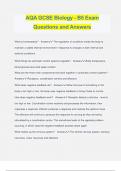
-
AQA GCSE Biology - B5 Exam Questions and Answers
- Exam (elaborations) • 16 pages • 2024
- Available in package deal
-
- $12.49
- + learn more
AQA GCSE Biology - B5 Exam Questions and Answers What is homeostasis? - Answer️️ -The regulation of conditions inside the body to maintain a stable internal environment in response to changes in both internal and external conditions What things do automatic control systems regulate? - Answer️️ -Body temperature, blood glucose level and water content What are the three main components that work together in automatic control systems? - Answer️️ -Receptors, coordination centres ...
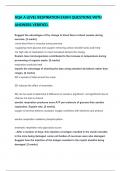
-
AQA A LEVEL RESPIRATION EXAM QUESTIONS WITH ANSWERS VERIFIED.
- Exam (elaborations) • 18 pages • 2024
-
Available in package deal
-
- $8.99
- + learn more
AQA A LEVEL RESPIRATION EXAM QUESTIONS WITH ANSWERS VERIFIED. Suggest the advantages of the change in blood flow in blood vessels during exercise. [3 marks] -more blood flow to muscles during exercise -supplying more glucose and oxygen/ removing carbon dioxide/ lactic acid/ heat -for high rate of respiration/ to meet increased demand for energy Explain how microorganisms contributed to the increase in temperature during processing of organic waste. [2 marks] respiration produces heat ex...
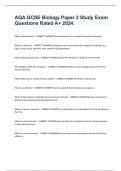
-
AQA GCSE Biology Paper 2 Final Exam Prep Questions 2024.
- Exam (elaborations) • 34 pages • 2024
-
Available in package deal
-
- $13.49
- + learn more
AQA GCSE Biology Paper 2 Final Exam Prep Questions 2024. What is homeostasis? - CORRECT ANSWER The maintenance of a constant internal environment. What is a stimulus? - CORRECT ANSWER A change in your environment than requires a response. e.g Light, sound, touch, pressure, pain, chemical or temperature. What do the receptors do? - CORRECT ANSWER Detect the stimulus or change in environment. What happens after the receptors? - CORRECT ANSWER Receptors send messages to the CNS via the se...
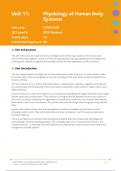
-
Physiology of Human Body Systems
- Exam (elaborations) • 13 pages • 2024
-
- $17.99
- + learn more
1 Know the levels of organisation within the human body Ultrastructure of an animal cell: plasma membrane; cytoplasm; nucleus; nucleolus; endoplasmic reticulum; golgi apparatus; vesicles; lysosomes; ribosomes; mitochondria; centrioles Tissue types: epithelial (glandular, lining, covering), eg salivary gland of digestive tract, endothelial lining of arteries and veins in the cardiovascular system, epithelial lining of lung tissue in the respiratory system; muscular, eg smooth muscle surro...
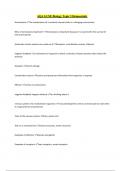
-
AQA GCSE Biology Topic 5 Homeostatis
- Exam (elaborations) • 9 pages • 2024
-
Available in package deal
-
- $9.99
- + learn more
AQA GCSE Biology Topic 5 Homeostatis Homeostasis The maintenance of a constant internal state in a changing environment Why is homeostasis important? Homeostasis is important because it is essential for the survival of cells and enzymes Automatic control systems are made up of Receptors, coordination centres, effectors negative feedback a mechanism of response in which a stimulus initiates reactions that reduce the stimulus Receptor Detects change Coordination centre Receives an...
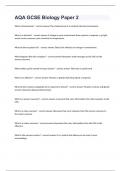
-
AQA GCSE Biology Paper 2 Comprehensive Exam .
- Exam (elaborations) • 34 pages • 2024
-
Available in package deal
-
- $13.99
- + learn more
What is homeostasis? - correct answer The maintenance of a constant internal environment. What is a stimulus? - correct answer A change in your environment than requires a response. e.g Light, sound, touch, pressure, pain, chemical or temperature. What do the receptors do? - correct answer Detect the stimulus or change in environment. What happens after the receptors? - correct answer Receptors send messages to the CNS via the sensory neurone. What makes up the central nervous system...
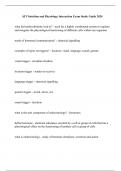
-
ATI Nutrition and Physiology Interaction Exam Study Guide 2024
- Exam (elaborations) • 60 pages • 2024
-
- $11.00
- + learn more
what did multicellularity lead to? - need for a highly coordinated system to regulate and integrate the physiological functioning of different cells within one organism mode of hormonal communication? - chemical signalling examples of types on triggers? - location, visual, language, sound, gesture visual trigger - circadian rhythms location trigger - sender to receiver language trigger - chemical signalling gesture trigger - social, stress, sex sound trigger - lactation what is the unit...
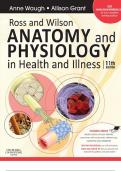
-
Ross and Wilson Anatomy and Physiology in Health and Illness_ With access to Ross & Wilson
- Class notes • 1316 pages • 2024
-
- $12.99
- + learn more
Levels of structural complexity Learning outcome After studying this section you should be able to: describe the levels of structural complexity within the body. Within the body are different levels of structural organisation and complexity. The most fundamental level is chemical. Atoms combine to form molecules, of which there are a vast range in the body. The structures, properties and functions of important biological molecules are considered in Chapter 2. Cells are the smallest indep...
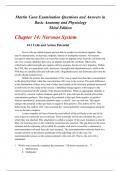
-
Chapter 14: Nervous System Martin Caon Examination Questions and Answers in Basic Anatomy and Physiology Third Edition
- Exam (elaborations) • 77 pages • 2023
-
Available in package deal
-
- $8.48
- + learn more
Martin Caon Examination Questions and Answers in Basic Anatomy and Physiology Third Edition Chapter 14: Nervous System 14.1 Cells and Action Potential 1. Which word correctly completes the statement: “All motor neurons are…”? a. Interneurons b. Multipolar c. Bipolar d. Unipolar Answer is B: Motor neurones (that innervate muscles) are multipolar. 2. In the peripheral nervous system, which cells form the myelin sheath? a. Ependymal cells b. Schwann cells c. Astrocytes d...
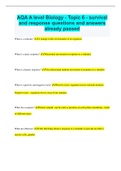
-
AQA A level Biology - Topic 6 - survival and response questions and answers already passed
- Exam (elaborations) • 43 pages • 2023
-
Available in package deal
-
- $10.99
- + learn more
AQA A level Biology - Topic 6 - survival and response questions and answers already passed What is a stimulus? A change in the environment of an organism What is a tactic response? Directional movement in response to a stimulus What is a kinetic response? Non directional random movement in response to a stimulus What is a positive and negative taxis? Positive taxis- organism moves towards stimulus Negative taxis - organism moves away from stimulus What Are receptors? Detect stimuli- can be c...

Study stress? For sellers on Stuvia, these are actually golden times. KA-CHING! Earn from your study resources too and start uploading now. Discover all about earning on Stuvia


